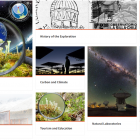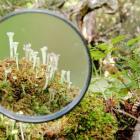Diversity and Beauty
Diversity and beauty are both in the eye of the observer and in the biophysical world. Often, very small and large objects are overlooked by humans. This section guides readers to appreciate the diversity of small organisms that form the microcosm in the biosphere, and very large and distant objects in the macrocosm of outer space.
Switch between the microcosm and macrocosm perspectives by clicking on the circles below.
The original virtual exhibition includes the option to switch between the microcosm and macrocosm within the individual chapters (see screenshot below).
Here we present the subchapters one after the other.
Small Is Beautiful
In the northwest arm of the Beagle Channel, we find subantarctic rainforests dominated primarily by the evergreen beech (Nothofagus betuloides) and accompanied by the winter’s bark (Drimys winteri) and low deciduous beech (Nothofagus antarctica). The trunks of these trees are covered by thick carpets of liverworts, mosses, and lichens. The floor of these forests is often covered by the devil’s strawberry (Gunnera magellanica), a small vascular plant that plays a critical ecological role in nitrogen fixation. If we use a hand lens to look closer at these luscious living carpets, we will marvel at the variety of textures, forms, and colors of the foliage of the diverse and beautiful mosses, liverworts, and lichens.
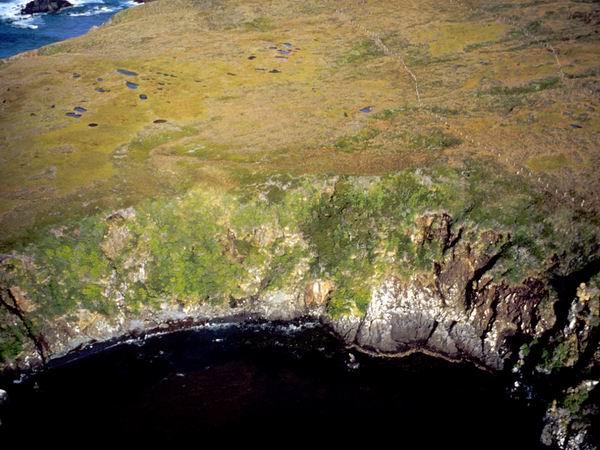
This picture, taken at the southeast peninsula of Horn Island, shows how at the extreme south of the Cape Horn Biosphere Reserve, subantarctic forests grow only on slopes or cliffs that are protected from the strong winds. Photograph by Ricardo Rozzi, n.d..
This picture, taken at the southeast peninsula of Horn Island, shows how at the extreme south of the Cape Horn Biosphere Reserve, subantarctic forests grow only on slopes or cliffs that are protected from the strong winds. Photograph by Ricardo Rozzi, n.d..
© Fundación Omora. Used by permission.
The copyright holder reserves, or holds for their own use, all the rights provided by copyright law, such as distribution, performance, and creation of derivative works.
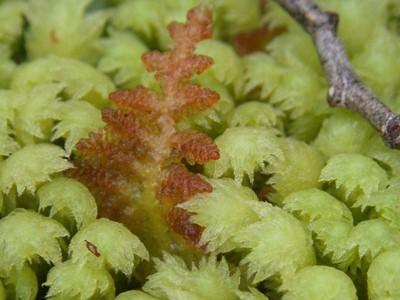
Inside the forests, the floor is covered by liverworts of genera like Schistochila (green) and Gackstroemia (brunette) that have beautiful foliage and unique reproductive structures such as the gemma cups on a thallus of Marchantia berteroana. Photograph by Kristin Hoelting, n.d.
Inside the forests, the floor is covered by liverworts of genera like Schistochila (green) and Gackstroemia (brunette) that have beautiful foliage and unique reproductive structures such as the gemma cups on a thallus of Marchantia berteroana. Photograph by Kristin Hoelting, n.d.
© Fundación Omora. Used by permission.
The copyright holder reserves, or holds for their own use, all the rights provided by copyright law, such as distribution, performance, and creation of derivative works.
Small Is Essential
Lichens receive the nickname of “ecosystem pioneers” due to their ability to colonize bare rocks and produce fertile soil. This process is critical in the glaciers of the Cape Horn Biosphere Reserve (CHBR). Lichens that contain cyanobacteria have the capacity to fix nitrogen from the atmosphere. In this manner they act as natural fertilizers for the soils. These processes facilitate the ecological succession that begins with the colonization of bare rocks by some mosses and lichens, which penetrate the rocks and form the first soil, thereby promoting the ecological succession followed by the colonization of grasses. In turn, these small plants generate the necessary substrate for the establishment of shrubs and trees. In this way, the little mosses and lichens have been ecologically essential for the establishment of the subantarctic forests in the archipelagoes of Cape Horn after the retreat of glaciers.
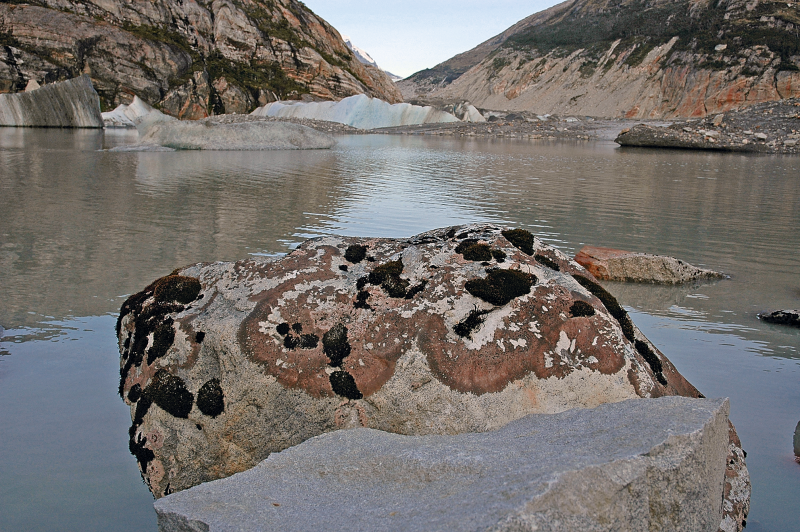
Processes of colonization and soil formation are extremely slow, requiring tens or hundreds of years. However, these processes begin immediately when rocks are uncovered, even when they are still semi-submerged in glacier ponds. Photograph by Ricardo Rozzi, n.d.
Processes of colonization and soil formation are extremely slow, requiring tens or hundreds of years. However, these processes begin immediately when rocks are uncovered, even when they are still semi-submerged in glacier ponds. Photograph by Ricardo Rozzi, n.d.
© Fundación Omora. Used by permission.
The copyright holder reserves, or holds for their own use, all the rights provided by copyright law, such as distribution, performance, and creation of derivative works.
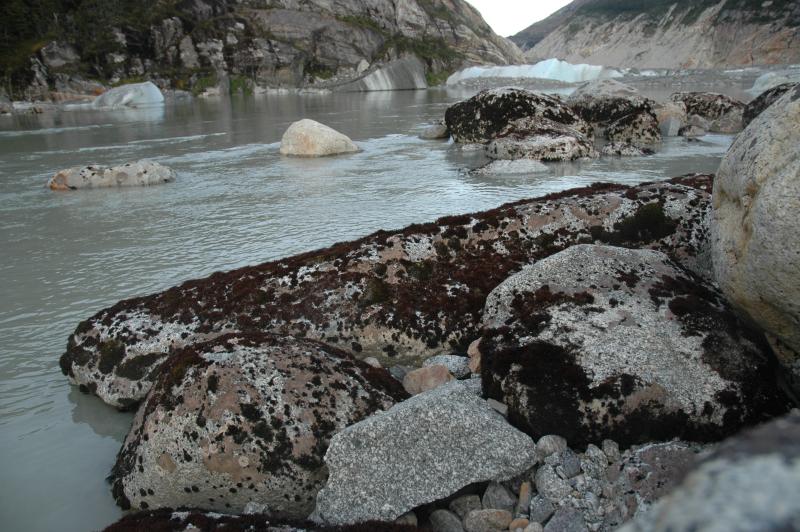
When we walk outwards from the glacier front, we can notice rocks that have been free of ice cover for a longer period of time. These rocks are covered by more lichens and mosses and are higher in species richness. Photograph by Ricardo Rozzi, n.d.
When we walk outwards from the glacier front, we can notice rocks that have been free of ice cover for a longer period of time. These rocks are covered by more lichens and mosses and are higher in species richness. Photograph by Ricardo Rozzi, n.d.
© Fundación Omora. Used by permission.
The copyright holder reserves, or holds for their own use, all the rights provided by copyright law, such as distribution, performance, and creation of derivative works.
Small Is Diverse
In Cape Horn, the forests are very different from the rest of the world. The diversity of trees is very low. We find only six species: three low trees (winter’s bark [Drimys winteri], pickwood [Maytenus magellanica], and the firebush [Embothrium coccineum]) and three tall tree species of beeches (the evergreen beech [Nothofagus betuloides], high deciduous beech [N. pumilio], and low deciduous beech [N. antarctica]. However, if we use a hand lens and look at the little flora, we will discover that on a single tree we can find over a hundred species of liverworts, mosses, and lichens growing on its trunk and branches.
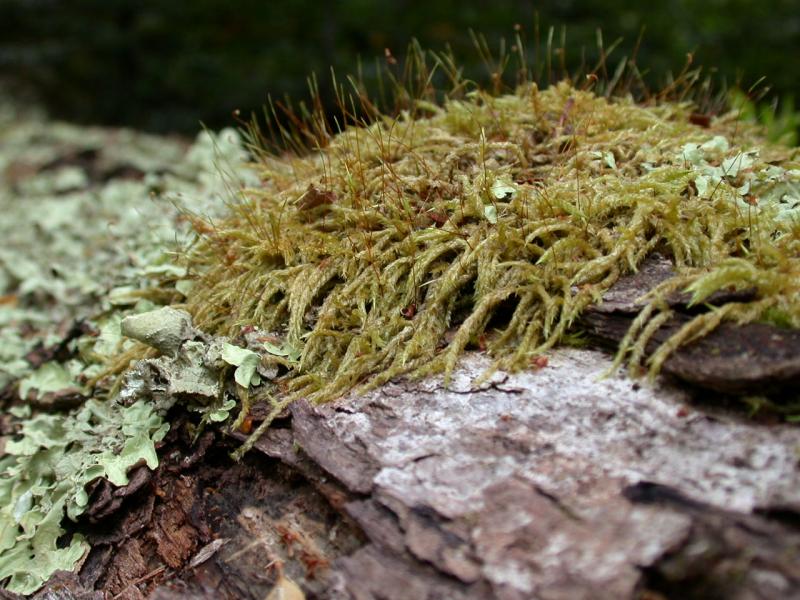
If we examine the trunk and branches of the old tree with a hand lens, we are able to distinguish the luscious and rich diversity of the “miniature forests” formed by foliose liverworts, smooth velvet-like mosses (Lepyrodon lagurus), “hairy” mosses (Dicranoloma sp.), branchy mosses (Acrocladium auriculatum), foliose lichens (Pseudocyphellaria spp., Peltigera sp.), fruticose lichens (Cladonia spp.), and crustose lichens (Calicium sp., Chrysothrix sp.). Photograph by Oliver Vogel, n.d.
If we examine the trunk and branches of the old tree with a hand lens, we are able to distinguish the luscious and rich diversity of the “miniature forests” formed by foliose liverworts, smooth velvet-like mosses (Lepyrodon lagurus), “hairy” mosses (Dicranoloma sp.), branchy mosses (Acrocladium auriculatum), foliose lichens (Pseudocyphellaria spp., Peltigera sp.), fruticose lichens (Cladonia spp.), and crustose lichens (Calicium sp., Chrysothrix sp.). Photograph by Oliver Vogel, n.d.
© Fundación Omora. Used by permission.
The copyright holder reserves, or holds for their own use, all the rights provided by copyright law, such as distribution, performance, and creation of derivative works.
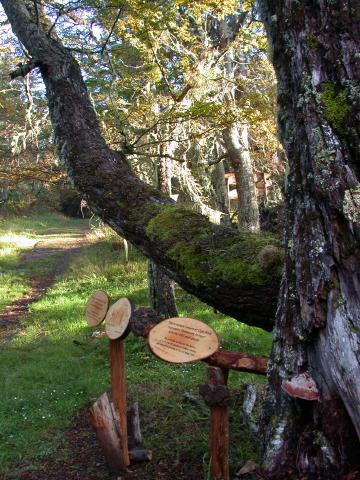
On the interpretive trail of the Omora Ethnobotanical Park, we find this large high deciduous beech (Nothofagus pumilio), which is a one-hundred-year-old tree with a large lateral branch. Photograph by Ricardo Rozzi, n.d.
On the interpretive trail of the Omora Ethnobotanical Park, we find this large high deciduous beech (Nothofagus pumilio), which is a one-hundred-year-old tree with a large lateral branch. Photograph by Ricardo Rozzi, n.d.
© Fundación Omora. Used by permission.
The copyright holder reserves, or holds for their own use, all the rights provided by copyright law, such as distribution, performance, and creation of derivative works.
The evergreen Magellanic rainforest in the subantarctic Magellanic ecoregion harbors at least 450 species of mosses and 368 species of liverworts. Hence, at least 818 bryophyte species of the 15,000 species that were known to science until 2008 grow at the southern extreme of South America. This ecoregion represents less than 0.01 percent of the terrestrial surface of the planet but contains more than 5 percent of all the little plants or bryophytes of the world. For this reason, the region of Cape Horn has been identified as a world “biodiversity hotspot.”

Creating a Diverse Cosmos
Diversity is not only found on Earth; it is key to explaining our cosmos as we know it. Without the diversity of structures, temperatures, and chemistry, we would not have life on Earth. However, diversity has had to be constructed throughout our existence and the cosmos has not always been the same as it is now. In the beginning, right after the Big Bang, the primordial universe was a hot “soup” of particles that slowly began to cool down as it expanded and the first atoms formed. After 370,000 years, the universe was composed mainly of hydrogen and helium, with traces of lithium, and it was finally transparent enough to allow the emission of photons. The first image we have of the universe corresponds to the radiation of these early photons. This electromagnetic radiation is called Cosmic Microwave Background (CMB). The CMB does not look as diverse or beautiful as the images of galaxies or nebula that we are accustomed to seeing, but it is proof of a complex beginning for an incredible future.

This diagram depicts the major milestones in the evolution of the universe since the Big Bang, about 13.8 billion years ago. It is not to scale. The universe was in a neutral state at 400,000 years after the Big Bang and remained that way until light from the first generation of stars started to ionize the hydrogen. After several hundred million years, the gas in the universe was completely ionized.
This diagram depicts the major milestones in the evolution of the universe since the Big Bang, about 13.8 billion years ago. It is not to scale. The universe was in a neutral state at 400,000 years after the Big Bang and remained that way until light from the first generation of stars started to ionize the hydrogen. After several hundred million years, the gas in the universe was completely ionized.
Courtesy of NAOJ.
Click here to view source.
 This work is licensed under a Creative Commons Attribution 4.0 International License.
This work is licensed under a Creative Commons Attribution 4.0 International License.
Diversity in the Stars
In order to create the first stars and galaxies, the material of our universe had to form structures. Driven mainly by the location of dark matter clumps, this material began to coalesce due to gravity and started to cool down. Cooling is essential, as it allows the material to collapse into a variety of objects, particularly stars. From Earth, stars seem like small flickering dots of light. However, there is a huge variety among them. They are mainly defined by the amount of mass that they accumulate during their formation process. Smaller stars are less massive, cooler, and have redder colors. Sun-like stars are white or yellow, while more massive stars show blue colors and reach very high temperatures. Each of these types of stars has a very different evolution and affects our universe in distinct ways.

This beautiful image, captured with the Focal Reducer and low-dispersion Spectrograph (FORS) on ESO’s Very Large Telescope (VLT), shows a field of stars of all ages—some looming close in the foreground and others lurking in the far distance. The distinct red and blue hues are thanks to the use of filters, which allow the selection of specific wavelength ranges of light. The images collected with different filters can be combined in order to create colorful composite images by assigning a particular color to each filter, coloring the images according to the filter used, and then combining the separate images. The result is a spectacular image, which brilliantly represents the various wavelengths of light.
This patch of sky is found in the constellation of Crux (the Southern Cross), an extremely bright section of the Milky Way. It was imaged as part of the ESO Cosmic Gems program, an outreach initiative to produce images of interesting, intriguing, or visually attractive objects using ESO telescopes for the purposes of education and public outreach. The program makes use of telescope time that cannot be used for science observations. All data collected may also be suitable for scientific purposes, and are made available to astronomers through the ESO Science Archive Facility.
This beautiful image, captured with the Focal Reducer and low-dispersion Spectrograph (FORS) on ESO’s Very Large Telescope (VLT), shows a field of stars of all ages—some looming close in the foreground and others lurking in the far distance. The distinct red and blue hues are thanks to the use of filters, which allow the selection of specific wavelength ranges of light. The images collected with different filters can be combined in order to create colorful composite images by assigning a particular color to each filter, coloring the images according to the filter used, and then combining the separate images. The result is a spectacular image, which brilliantly represents the various wavelengths of light.
This patch of sky is found in the constellation of Crux (the Southern Cross), an extremely bright section of the Milky Way. It was imaged as part of the ESO Cosmic Gems program, an outreach initiative to produce images of interesting, intriguing, or visually attractive objects using ESO telescopes for the purposes of education and public outreach. The program makes use of telescope time that cannot be used for science observations. All data collected may also be suitable for scientific purposes, and are made available to astronomers through the ESO Science Archive Facility.
Courtesy of ESO.
Click here to view source.
 This work is licensed under a Creative Commons Attribution 4.0 International License.
This work is licensed under a Creative Commons Attribution 4.0 International License.
Blue giants, the largest of stars, will be able to create high-pressure conditions in their interiors and, through nuclear fusion, form chemical elements up to iron. At the end of their stellar lifetimes, these massive stars collapse in the form of supernovae and the leftover material contracts into either a neutron star or a black hole, the densest objects in the universe. Supernovae are also an opportunity for more chemical elements to form and for the elements created within the star to be spread out into the interstellar medium. Stars like the Earth’s Sun combine hydrogen and helium in their interiors to form elements such as oxygen, nitrogen, and carbon, key to life on Earth. These elements are distributed to their surroundings when they expel their outer layers in what is known as a planetary nebula. Finally, the smallest of stars slowly combine hydrogen to form helium and live the longest, which allows us to use them as lower limits for determining the age of our universe.
Beautiful Galactic Structures
Stars can be regarded as the building blocks of galaxies. Each galaxy hosts hundreds of thousands, even millions, of stars. When we observe the most distant objects in the universe, we observe galaxies. Their bright glows allow us to identify them even when they have been dimmed by the distance and expansion of the universe. Galaxies are diverse and beautiful: some show bright spirals where stars are forming and others show an orange-red glow, which can be related to an older stellar population. Galaxies have also allowed us a glimpse into their merging processes, and we have several examples of the cosmic dance that happens as these massive objects interact and join. Perhaps the most beautiful thing that galaxies have shown us is not their shapes or colors, but rather the knowledge that the universe is expanding. Through the study of these galactic structures, we are able to determine the rate at which our cosmos grows and trace the initial moments of the universe as we observe back at the dimmest of objects. The most wondrous aspect of all the amazing astronomical pictures are the questions we can answer by studying them.
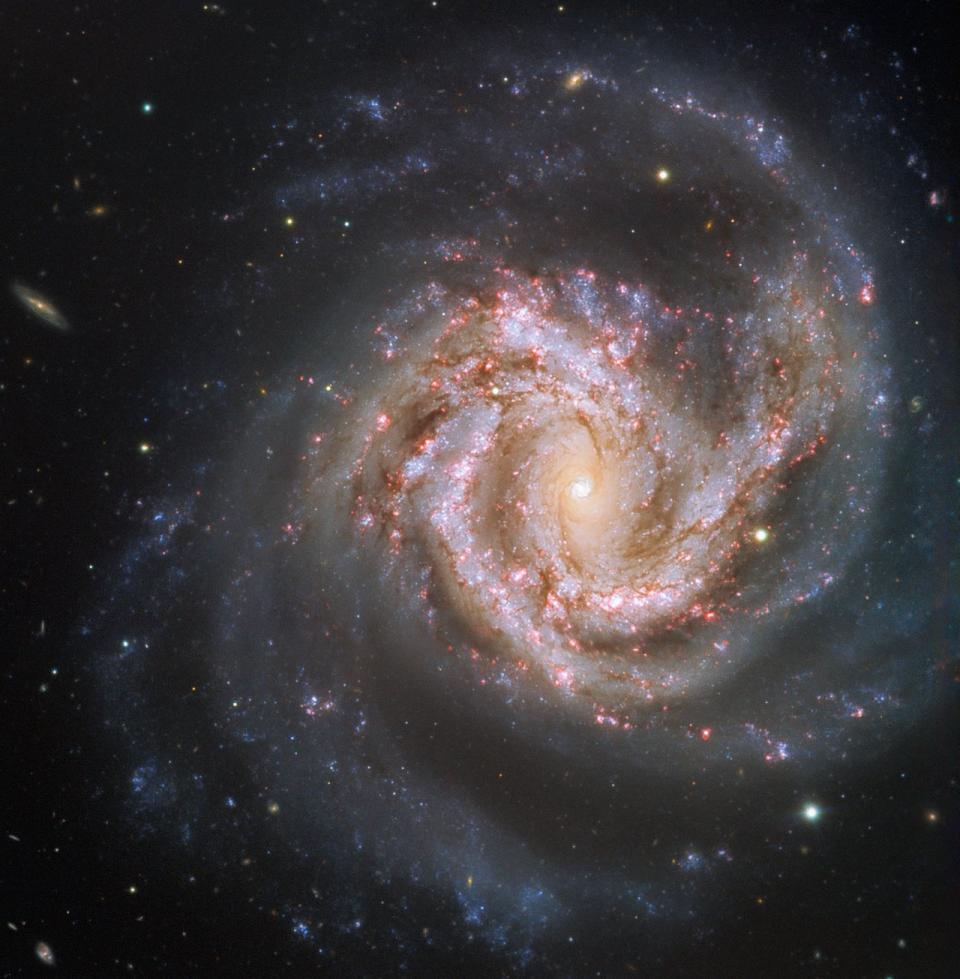
Nuzzled in the chest of the constellation Virgo (the Virgin) lies a beautiful cosmic gem—the galaxy Messier 61. This glittering spiral galaxy is aligned face-on toward Earth, thus presenting us with a breathtaking view of its structure. The gas and dust of the intricate spiral arms are studded with billions of stars. This galaxy is a bustling hub of activity with a rapid rate of star formation, and both a massive nuclear star cluster and a supermassive black hole are buried at its heart.
Messier 61 is one of the largest members of the Virgo Cluster, which is made up of more than a thousand galaxies, and is itself at the center of the Virgo Supercluster—to which our Milky Way also belongs. This dazzling beauty was first discovered in 1779, and it has been capturing astronomers’ interest ever since. Set against a dark sky littered with galaxies, this image shows the awe-inspiring M61 in its full glory—even at its distance of over 50 million light-years.
This image was taken as part of ESO’s Cosmic Gems program, an outreach initiative to produce images of interesting, intriguing, or visually attractive objects using ESO telescopes for the purposes of education and public outreach. The program makes use of telescope time that cannot be used for science observations. In case the data collected could be useful for future scientific purposes, these observations are saved and made available to astronomers through the ESO Science Archive Facility.
Nuzzled in the chest of the constellation Virgo (the Virgin) lies a beautiful cosmic gem—the galaxy Messier 61. This glittering spiral galaxy is aligned face-on toward Earth, thus presenting us with a breathtaking view of its structure. The gas and dust of the intricate spiral arms are studded with billions of stars. This galaxy is a bustling hub of activity with a rapid rate of star formation, and both a massive nuclear star cluster and a supermassive black hole are buried at its heart.
Messier 61 is one of the largest members of the Virgo Cluster, which is made up of more than a thousand galaxies, and is itself at the center of the Virgo Supercluster—to which our Milky Way also belongs. This dazzling beauty was first discovered in 1779, and it has been capturing astronomers’ interest ever since. Set against a dark sky littered with galaxies, this image shows the awe-inspiring M61 in its full glory—even at its distance of over 50 million light-years.
This image was taken as part of ESO’s Cosmic Gems program, an outreach initiative to produce images of interesting, intriguing, or visually attractive objects using ESO telescopes for the purposes of education and public outreach. The program makes use of telescope time that cannot be used for science observations. In case the data collected could be useful for future scientific purposes, these observations are saved and made available to astronomers through the ESO Science Archive Facility.
Courtesy of ESO.
Click here to view source.
 This work is licensed under a Creative Commons Attribution 4.0 International License.
This work is licensed under a Creative Commons Attribution 4.0 International License.
Switch between the microcosm and macrocosm perspectives by clicking on the circles above.




